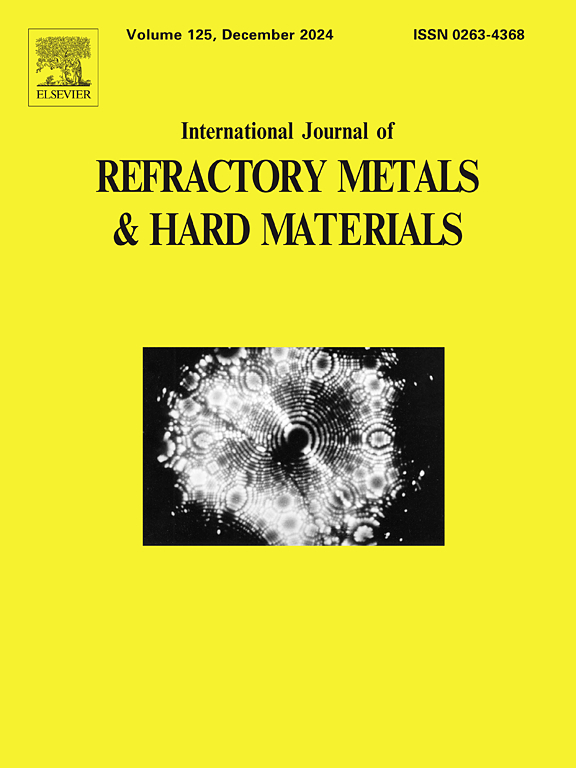钒纳米片和石墨烯纳米片诱导原位硬相增强直接能沉积Inconel 625的高温抗磨性能
IF 4.2
2区 材料科学
Q2 MATERIALS SCIENCE, MULTIDISCIPLINARY
International Journal of Refractory Metals & Hard Materials
Pub Date : 2025-05-02
DOI:10.1016/j.ijrmhm.2025.107216
引用次数: 0
摘要
为了开发高温抗磨性能的镍基复合材料,基于原位生成原理,将Inconel 625 (IN625)、钒(V)和石墨烯纳米片(GNPs)混合在一起。采用激光直接能量沉积(LDED)技术制备了具有x V/GNPs (x = 4,8,12)的IN625和IN625金属基复合材料(MMC)涂层。研究了V和GNPs对IN625显微组织、显微硬度和摩擦学性能的影响。结果表明:V和GNPs的加入促进了硬相(Nb, V)C和Cr23C6的原位析出,有利于晶粒细化;随着V和GNPs含量的增加,IN625 MMC涂层的显微硬度和抗磨性能逐渐提高。与IN625相比,12wt %-V/GNPs涂层的显微硬度和室温抗磨性能分别提高了32.3%和3.5倍。此外,四种涂层在高温下的磨损率降低,这与氧化釉的形成有关。IN625 MMC涂层高温抗磨性能的提高可归因于润滑相V2O5的形成。本文章由计算机程序翻译,如有差异,请以英文原文为准。
Boosted high-temperature anti-wear of direct energy deposited Inconel 625 via vanadium and graphene nanoplatelets-induced in-situ hard phases
To develop high-temperature anti-wear performance nickel-based composites, Inconel 625 (IN625), vanadium (V), and graphene nanoplatelets (GNPs) are mixed based on the principle of in-situ generation. IN625 and IN625 metal matrix composite (MMC) coatings with x V/GNPs (x = 4, 8, 12) were then prepared using Laser Direct Energy Deposition (LDED). The effects of V and GNPs on the microstructure, microhardness, and tribological properties of IN625 were investigated. The results showed that the addition of V and GNPs promoted the in-situ precipitation of hard phases (Nb, V)C and Cr23C6, which contributed to grain refinement. As the content of V and GNPs increased, the microhardness and anti-wear performance of IN625 MMC coatings gradually improved. Compared to IN625, the microhardness and room-temperature anti-wear performance of the 12 wt%-V/GNPs coating increased by 32.3 % and 3.5 times, respectively. Additionally, the wear rate of the four coatings decreased at a high temperature, which was associated with the forming of an oxide glaze. The improved high-temperature anti-wear performance of the IN625 MMC coatings can be attributed to the formation of the lubricating phase V2O5.
求助全文
通过发布文献求助,成功后即可免费获取论文全文。
去求助
来源期刊
CiteScore
7.00
自引率
13.90%
发文量
236
审稿时长
35 days
期刊介绍:
The International Journal of Refractory Metals and Hard Materials (IJRMHM) publishes original research articles concerned with all aspects of refractory metals and hard materials. Refractory metals are defined as metals with melting points higher than 1800 °C. These are tungsten, molybdenum, chromium, tantalum, niobium, hafnium, and rhenium, as well as many compounds and alloys based thereupon. Hard materials that are included in the scope of this journal are defined as materials with hardness values higher than 1000 kg/mm2, primarily intended for applications as manufacturing tools or wear resistant components in mechanical systems. Thus they encompass carbides, nitrides and borides of metals, and related compounds. A special focus of this journal is put on the family of hardmetals, which is also known as cemented tungsten carbide, and cermets which are based on titanium carbide and carbonitrides with or without a metal binder. Ceramics and superhard materials including diamond and cubic boron nitride may also be accepted provided the subject material is presented as hard materials as defined above.

 求助内容:
求助内容: 应助结果提醒方式:
应助结果提醒方式:


